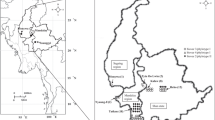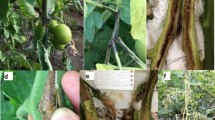Abstract
Stem and pith necrosis symptoms on tomato and midrib rot symptoms on lettuce were observed in West and East Azarbayjan of Iran. Infected organs of the plants were collected and bacterial strains were isolated on NA medium. Biochemical and physiological properties such as LOPAT test, fluorescent pigment production and utilization of carbon source, demonstrated that the strains were Pseudomonas cichorii. All strains were pathogenic on tomato and lettuce plants. To assess genetic diversity among the strains, BOX and ERIC-PCR analyses were employed. Clustering of ERIC and BOX-PCR results with UPGMA and Jaccard’s similarity coefficients showed that strains were clustered into two main groups at a similarity level of 52%. Strains of groups 1 and 2 isolated from lettuce and tomato, respectively. The gyrB, rpoD and 16S rRNA nucleotide sequences showed high similarity and the sequence similarity between the Iranian strains and P. cichorii reference strain were 98.9, 98.7 and 99.5%, indicating a close phylogenetic relationship between the strains. According to the past references and researches in Iran, this is the first report of isolation and identification of Pseudomonas cichorii, the causative agent of tomato pith necrosis and lettuce midirib rot in North West of Iran.





Similar content being viewed by others
References
Berge O, Monteil CL, Bartoli C, Chandeysson C, Guilbaud C, Sands DC, Morris CE (2014) A user’s guide to a data base of the diversity of Pseudomonas syringae and its application to classifying strains in this phylogenetic complex. PLoS ONE 9:e105547
Cottyn B, Heylen K, Heyrman J, Vanhouteghem K, Pauwelyn E, Bleyaert P, Van Vaerenbergh J, Höfte M, De Vos P, Maes M (2009) Pseudomonas cichorii as the causal agent of midrib rot, an emerging disease of greenhouse-grown butter head lettuce in Flanders. Sys Appl Microb 32:211–225
Fariis JS (1969) On the cophenetic correlation coefficient. Sys Zool 18:279–285
Hildebrand DC, Schroth MN, Sands DC (1988) Pseudomonas, In: N. W. Schaad (Ed.), Laboratory Guide for the identification of plant pathogenic bacteria (pp. 60–80). 2nd edn. St. Paul, Minnesota, USA: APS Press
Hwang MSH, Morgan RL, Sarkar SF, Wang PW, Guttman DS (2005) Phylogenetic characterization of virulence and resistance phenotypes of Pseudomonas syringae. Appl Environ Microb 9:5182–5191
Jaccard P (1901) Étude comparative de la distribuition florale dans une portion des Alpes et des Jura. Bull Soc Vaudoise Sci Nat 37:547–579
Keshtkar A, Khodakaramian G, Rouhrazi K (2016) Isolation and characterization of Pseudomonas syringae pv. syringae which induce leaf spot on walnut. Eur J Plant Pathol 146:837–846
Kim OS, Cho YJ, Lee K, Yoon SH, Kim M, Na H, Park SC, Jeon YS, Lee JH, Yi H, Won S, Chun J (2012) Introducing EzTaxon-e: a prokaryotic 16S rRNA gene sequence database with phylotypes that represent uncultured species. Inter J Sys Evol Microb 62:716–721
Kimura MA (1980) Simple method for estimating evolutionary rates of base substitutions through comparative studies of nucleotide sequences. J Molec Evol 16:111–120
King ED, Ward MK, Raney DE (1954) Two simple media for the demonstration of pyocyanin and fluorescin. J Lab Clin Medi 44:301–307
Klement Z (1963) Method for the rapid detection of the pathogenicity of phytopathogenic Pseudomonas. Nature 199:299–300
Lelliott RA, Stead DE (1987) Methods for the diagnosis of bacterial diseases of plants. Blackwell Scientific Publications, Oxford, UK
Lelliott RA, Billing E, Hayward AC (1966) A determinative scheme for the fluorescent plant pathogenic Pseudomonads. J Appl Microb 29:470–489
Lonetto M, Gribskov M, Gross CA (1992) The sigma 70 family: sequence conservation and evolutionary relationships. J Bacteriol 174:3843–3849
Manceau C, Horvais A (1997) Assessment of genetic diversity among strains of Pseudomonas syringae by PCR restriction fragment length polymorphism analysis of rRNA operons with special emphasis on P. syringae pv. tomato. Appl Environ Microb 63:498–505
Marques E, Borges RCF, Uesugi CH (2016) Identification and pathogenicity of Pseudomonas cichorii associated with a bacterial blight of gerbera in the Federal District. Horti Brasil 34:224–248
Mirik M, Aysan Y, Sahin F (2011) Characterization of Pseudomonas cichorii isolated from different hosts in Turkey. Inter J Agri Biol 13:203–209
Moore R, Dowding J, Bratt H, Gawron JM, Gorfu Y, Cheyer A (1996) Commandtalk: a spoken-language interface for battlefield simulation. Technical report, Artificial Intelligence Center, SRI International
Nei M, Maruyama T, Chakraborty R (1975) The bottleneck effect and genetic variability in populations. Evolution 29:1–10
Nosratnezhad F, Rouhrazi K, Khezrinezhad N (2018) Characterization and genetic diversity of Pseudomonas syringae isolates from stone fruits in north-western Iran. J Phytopath 166:516–524
Pernezny K, Datnoff L, Sommerfeld ML (1994) Brown stem of celery caused by Pseudomonas cichorii. Plant Dis 78:917–919
Rohlf FJ (1993) NTSYS-pc: Numerical taxonomy and multivariate analysis system. Version 2.0. New York, NY: Exeter Software
Rouhrazi K, Rahimian H (2012) Characterization of Iranian grapevine isolates of Rhizobium (Agrobacterium) spp. J Plant Pathol 94:555–560
Ruan H, Shi N, Du Y, Chen F, Yang X, Gan L, Dai Y (2018) First report of Pseudomonas cichorii causing tomato pith necrosis in Fujian Province. China Plant Dis 103(1):145
Saitou N, Nei M (1987) The neighbor-joining method: a new method for reconstructing phylogenetic trees. Mol Biol Evol 4:406–425
Schaad NW, Jones JB, Chun W (2001) Laboratory guide for the identification of plant pathogenic bacteria, 3rd edn. Phytopathological Society St, Paul, Minnesota, USA
Sneath PHA, Sokal RR (1973) Numerical Taxonomy. Freeman, San Francisco
Stead DE, Simpkins SA, Weller SA, Hennessy J, Aspin A, Stanford H, Smith NC, Elphinstone JG (2003) Classification and identification of plant pathogenic Pseudomonas species by REP-PCR derived genetic fingerprints. In: Iacobellis NS, Collmer A, Hutcheson SW et al (eds) Pseudomonas syringae and related pathogens: Biology and genetics. Kluwer Academic Publishers, Dordrechts, pp 411–421
Tamura K, Stecher G, Peterson D, Filipski A, Kumar S (2013) MEGA6: Molecular Evolutionary Genetics Analysis Version 6.0. Mol Biol Evol 30:2725–2729
Tayeb LA, Ageron E, Grimont F, Grimont PAD (2005) Molecular phylogeny of the genus Pseudomonas based on rpoB sequences and application for the identification of isolates. Res Microb 156:763–773
Timilsina S, Adkinson H, Testen AL, Newberry EA, Miller SA, Paret ML, Minsavage GV, Goss EM, Jones JB, Vallad GE (2017) A novel phylogroup of Pseudomonas cichorii identified following an unusual disease outbreak on tomato. Phytopathol 107:1298–1304
Thompson JD, Gibson TJ, Plewniak F, Jeanmougin F, Higgins DG (1997) The clustal_X windows interface: flexible strategies for multiple sequence alignement aided by quality analysis tools. Nucl Aci Res 25:4876–4882
Trantas EA, Sarris PF, Mpalantinaki EE, Pentari MG, Ververidis F, Goumas DE (2013) A new genomovar of Pseudomonas cichorii, a causal agent of tomato pith necrosis. Eur J Plant Pathol 137:477–493
Verhille Baı ¨da, N, Dabboussi F, Hamze M, Izard D, Leclerc H (1999) Pseudomonas gessardii sp. nov. and Pseudomonas migulae sp. nov., two new species isolated from natural mineral waters. Int JSys Bacter 49(4):1559–1572
Versalovic J, Koeuth T, Lupski JR (1991) Distribution or repetitive DNA– sequences in eubacteria and application of fingerprinting of bacterial genomes. Nuc Aci Res 19:6823–6831
Versalovic J, Schneider M, de Bruijn FJ, Lupski JR (1994) Genomic fingerprinting of bacteria using repetitive sequence-based polymerase chain reaction. Meth Molec Cell Biol 5:25–40
Watt PM, Hickson ID (1994) Structure and function of type II DNA topoisomerases. Bio J 303:681–695
Weisburg WG, Barns SM, Pelletior DA, Lanem DJ (1991) 16S ribosomal DNA amplification for phylogenetic study. J Bac 173:697–703
Wilkie P, Dye DW (1974) Pseudomonas cichorii causing tomato and celery diseases in New Zealand. New Zealand J Agri Res 17:123–130
Yamamoto S, Kasai H, Arnold DL, Jackson RW, Vivian A, Harayama S (2000) Phylogeny of the genus Pseudomonas: intrageneric structure reconstructed from the nucleotide sequences of gyrB and rpoD genes. Microbiology 146:2385–2394
Funding
No funding was received to assist with the preparation of this manuscript.
Author information
Authors and Affiliations
Corresponding author
Ethics declarations
Research involving human and animal participants
This article does not contain any studies with human participants or animals performed by any of the authors. It is original and has not been published elsewhere.
Conflict of interest
All authors declare that no competing interests exist.
Additional information
Publisher's Note
Springer Nature remains neutral with regard to jurisdictional claims in published maps and institutional affiliations.
Rights and permissions
About this article
Cite this article
Arshad, S., Nematollahi, S., Rouhrazi, K. et al. Characterization of Pseudomonas cichorii isolated from tomato and lettuce in Iran. J Plant Pathol 103, 853–861 (2021). https://doi.org/10.1007/s42161-021-00863-9
Received:
Accepted:
Published:
Issue Date:
DOI: https://doi.org/10.1007/s42161-021-00863-9




